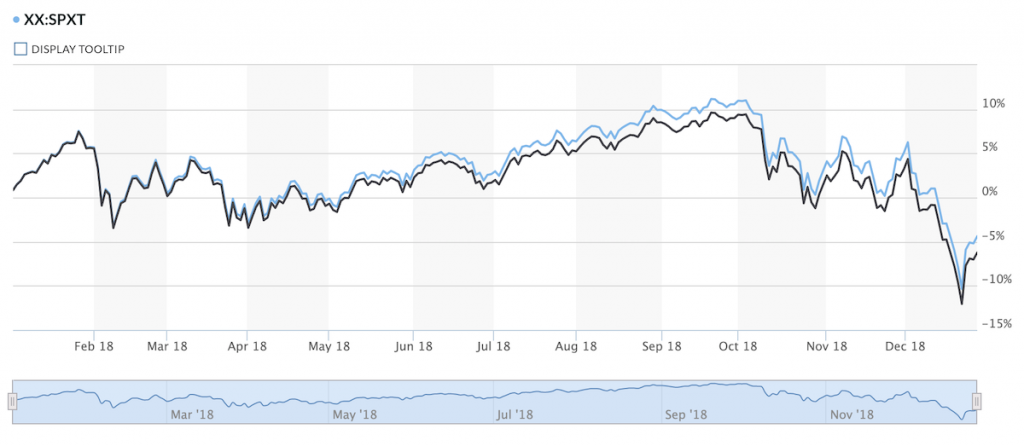The S&P 500 Price index returned -6.59% in 2018. Using a better calculation which includes dividend reinvestment, the S&P 500 returned -4.75%.
The 2018 S&P 500 Return: Buy, Hold and Reinvest
The quoted numbers require that you bought the opening trade on January 2nd, 2018 and sold the closing trade on December 31, 2018. If you'd prefer the numbers buying at the December 29, 2017 closing price the returns would be -6.24% and -4.38%, respectively.
For the index price returns, here's the breakdown:
| Price From | Price | Dec 31 Close | Gain/Loss |
| Jan 2 Open | 2683.73 | 2506.85 | -6.59% |
| Dec 29 Close | 2673.61 | 2506.85 | -6.24% |
For the index dividend-reinvested returns, here are the details:
| Dividend Reinvested From | Price | Dec 31 Close | Gain/Loss |
| Jan 2 Open | 5232.72 | 4984.22 | -4.75% |
| Dec 29 Close | 5212.76 | 4984.22 | -4.38% |
Whichever set of return time-spans you prefer (and it doesn't really matter), the message this year remains the same: dividends matter. Neither return quote looks particularly healthy, but it's important not to discard dividends to better match the performance of actual investors.
Simply quoting price returns without regard to real returns due to the effects of reinvesting funds doesn't reveal the true return on an investment. Don't accept price returns at face value.
Source on the 2018 S&P 500 Return Calculations
S&P Dow Jones Indices owns and maintains the S&P 500 Index. They have both the classic S&P 500 price index as well as the dividend reinvested numbers (from 1987 forward).
Want more than this post can give you? While we don't (yet?) have a daily return calculator, we have some monthly resolution calculators for the S&P 500:
- S&P 500 Dividend Reinvestment Calculator
A lump sum investment return calculator between dates. - S&P 500 Periodic Reinvestment and Dividend Calculator
A calculator which estimates fees and taxes. It allows periodic scheduled additions to investments. - S&P 500 Historical Return Calculator
A calculator which works on constant time-frames in the S&P 500 dataset, calculating ordered sets of returns. - CAPE Calculator
Computes the 10-year PE ratio of the S&P 500 index. Also lets you change the period of returns (9-year PE, anyone?).
The 2018 S&P 500 Return
You can find both the S&P 500 and the Total Return at Marketwatch. Here's the overlay for 2018:

Factoring in dividends and reinvestment moved the return from a mid 6%s loss to under 5%. While no investor perfectly timed openings and closing (and all faced fees and taxes!) it's important to attempt to factor in the effects of dividends.
In fact, in 2018 and 2019 many brokerage accounts allow you to automatically set up dividend reinvestment on your stocks and funds. Some will even do it for free and account for fractional shares.
Make sure you know where your dividends end up! Good luck in 2019.
Other years:
- 2023 S&P 500 Return
- 2022 S&P 500 Return
- 2021 S&P 500 Return
- 2020 S&P 500 Return
- 2019 S&P 500 Return
- 2017 S&P 500 Return
- 2016 S&P 500 Return
- 2015 S&P 500 Return
- 2014 S&P 500 Return
- 2013 S&P 500 Return
- 2012 S&P 500 Return
What do you see the S&P 500 doing in 2019?
